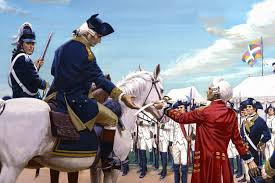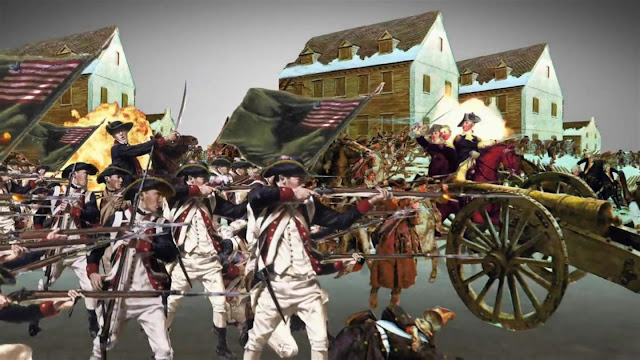The role of the French in making the American Revolution a success, The History of the American Revolution
Americans have always been grateful for the help and cooperation of the French in the American
Revolution. The oil painting of the British surrender in Yorktown, which is still hanging in the US
Capitol Museum is clear. The decision of the painter John Trumbull to depict the French on an equal
footing with the Americans as opposed to the British clearly indicates that the architects of the United
States have been treating the French with respect ever since. And the Statue of Liberty sent by the
French to the United States as a gift of friendship a hundred years after the American Revolution still
stands proudly on the New York coast. Ideological inspiration On March 23, 1775, Patrick Henry, one of the leading architects of the United States, delivered a historic speech at the Second Virginia Conference. Many historians believe that the phrase "give me freedom or die" accelerated the armed struggle of the American Revolution. The conference was attended by Thomas Jefferson, George Washington, and representatives from every region of colonial America. At the conference, he highlighted the importance of armed struggle. Henry's speech echoed a historical work by the French philosopher Jean-Jacques Rousseau. "People are born free, but they are captives everywhere," Rousseau wrote in The Social Contract in 1762
Historians believe that American architects and their supporters adopted French political
philosophy in the 180's. In the regional war is known as the Seven Years' War, the British
were militarily stronger than the French. But how the future American architects trampled
on the British in their own constitution completely changed the course of the revolution at that time.
The friendship of the American leaders with France was a big concern in the British camp to
get the idea of freedom and independence. Lawrence Kaplan, a professor of history at Kent
State University, writes: For the colonists, supporting the French was as much a duty as a
kind of patriotism. At least to oppose the growing enemy British! The French philosopher
Rousseau spoke of sovereignty, not kings in one place. He also mentioned the need to
make laws for the welfare of the people as a majority group. Thomas Jefferson used many
of Rousseau's sayings, "All men are created equal." However, Baron de Montesquieu's
imprint on the US draft constitution is more noticeable. In his book, The Spirit of Law,
Baron speaks of forming a government based on balance and equality to avoid
dictatorship. So it is difficult to imagine whether the revolution would have succeeded without
the inspiration of these two French philosophers at such a difficult time for the Americans.
They posed a greater geopolitical threat to Britain Defeated in the Seven Years' War, the
French lost almost all of their colonies, including Canada. And so the French Revolution
and its advisers saw the American Revolution as a golden opportunity for revenge. At the same
time, they found an opportunity to overthrow the British and re-establish the empire. The then
Foreign Minister of France, Willie Comte, told King Louis XII of the
importance of being active in the American Revolution through multiple meetings. His argument was,
'This moment of humiliation and revenge by the British is useful and proven.'
Secretly providing assistance:
One evening in 1775, Benjamin Franklin, an American architect, traveled with four colleagues to a secret meeting at the Philadelphia Carpenters' Hall. He was one of the delegates to the Second Continental Conference. He is also one of the main members of the secret committee. The BritishProvides money, equipment and troops:
No great plan can succeed without capital. And when it comes to freedom, money, troops and all the equipment are necessary. From the very first day of opposition to the British, the American coup relied on the unconditional support of the French. And Silas Dean and his team succeeded in realizing that strength and cooperation. In the end, France provided ৩ 1.3 billion in equipment and cash. Statistics show that at the time of the conquest of Saragota in October 18, the US military had 90 percent of its weapons supplied by France. At the same time, all the guns in their hands were French. The French also provided complete gunpowder for that war.
After the conquest of Saragota, the French increased their cooperation. The deployment of troops directly from France began in the 18th century, after the formation of an alliance with American pro-independence leaders and the conclusion of a trade agreement. Across the Atlantic, 22,000 navies took part in direct combat on about 63 French warships. Another 12,000 French troops took up arms against the British. Commander Comte de Rochambe, who led the French forces, inspired his troops to unite. St. Domingo, on the other hand, led by Comte de Grasse, won the Battle of Chesapeake against the British navy in 181, adding the French navy from present-day Haiti to the Virginia navy. The entire force, led by George Washington, Lafayette, and Rochambay, later hit Yorktown collectively. And the British surrendered there.
Provide political legitimacy to freedom-loving leaders:
The whole world, except France and its allies, at the time was denouncing the United States and its pro-independence leaders as traitors who only "rebelled against the ruler." The secret meetings between the two sides before the armed conflict helped to develop the relations of the American leaders with the French. The agreements signed between the two countries in 18 recognized the United States as an independent country and opened the way for international trade. Although Spain signed a treaty with the United States in 179 for the sake of friendly relations, they could not play a greater role than the French.
After the surrender of the British in Yorktown, France once again extended a hand of diplomatic assistance. In 183, on the eve of the historic Paris Agreement, Britain offered a peace treaty to both sides. Both France and the United States rejected the British offer in favor of the French Foreign Minister Virginia. The British eventually forced the Americas to declare the territory independent and signed the Treaty of Paris, relinquishing most of the territory east of the Mississippi River. France's intervention or role led to the recognition of America as an independent America from the British colony through the Treaty of Paris, which later became known as the Union of America and now the United States of America.

















No comments:
Post a Comment